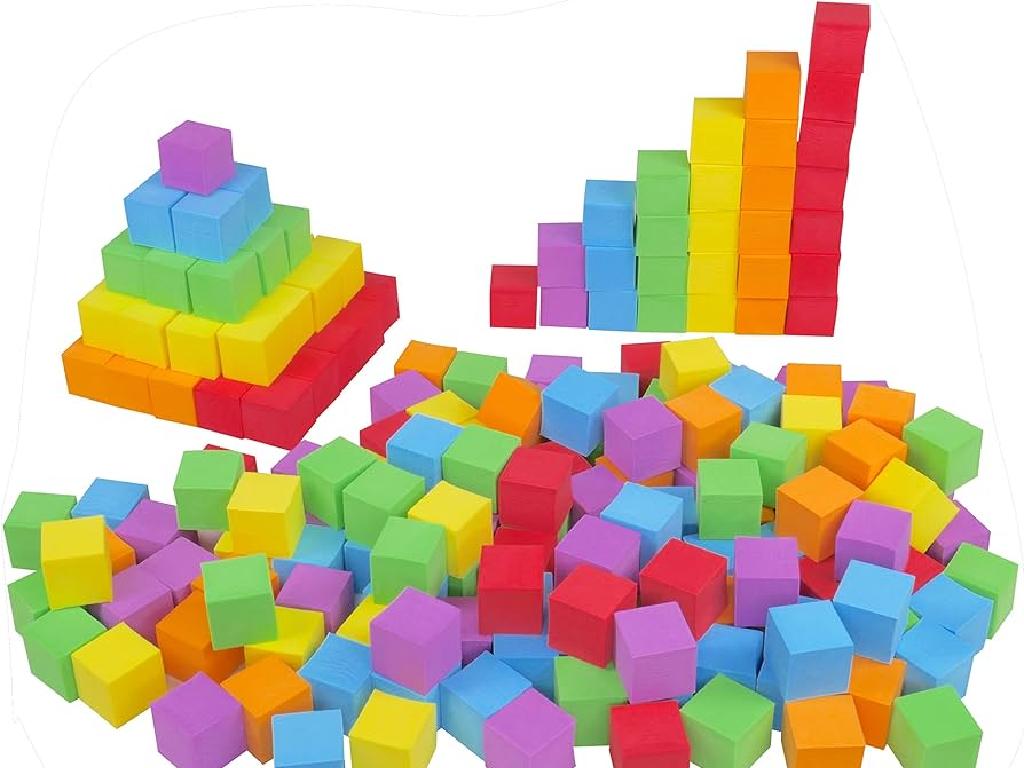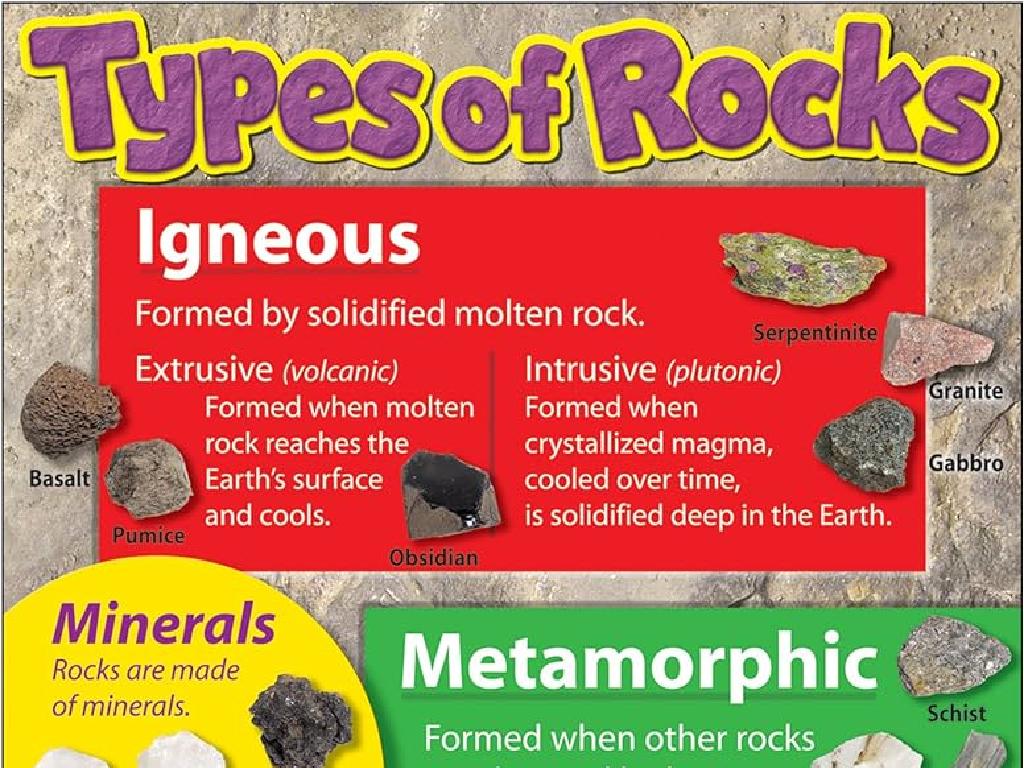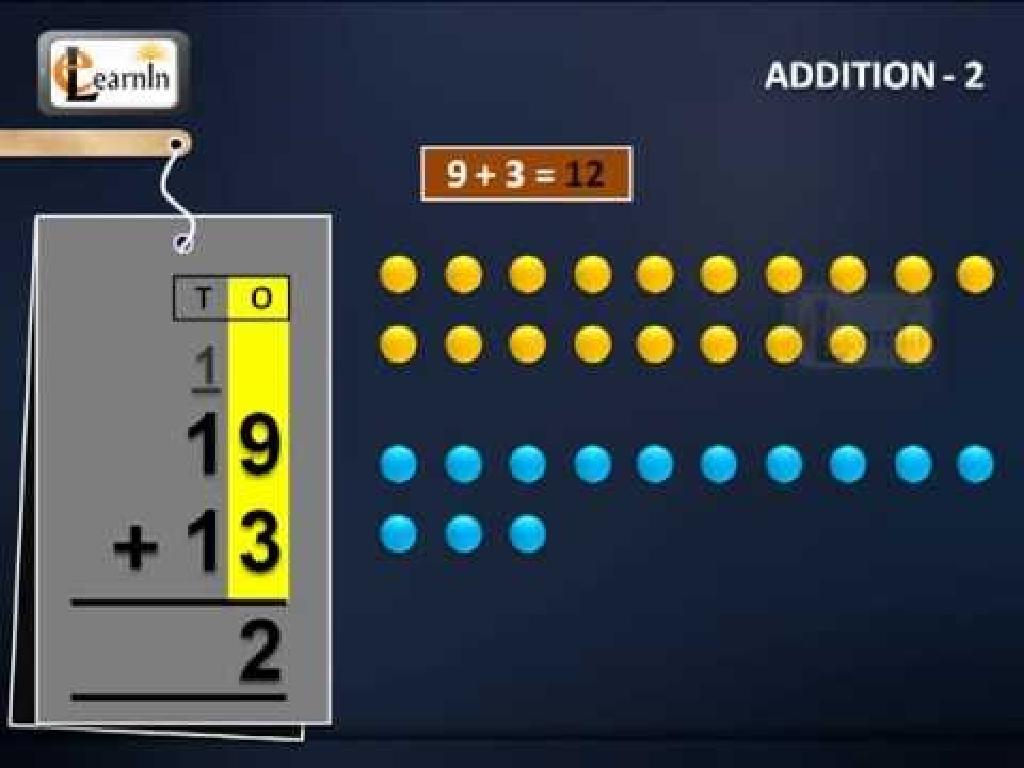Identify Proportional Relationships From Graphs
Subject: Math
Grade: Sixth grade
Topic: Proportional Relationships
Please LOG IN to download the presentation. Access is available to registered users only.
View More Content
Identifying Proportional Relationships from Graphs
– What are proportional relationships?
– A proportional relationship is two quantities increasing or decreasing at the same rate.
– Proportions in daily life
– Examples: recipes in cooking, buying fruits by the pound.
– Graphs show proportional relationships
– Straight lines through the origin (0,0) on a graph indicate proportionality.
– Practice identifying proportions
|
Begin with a clear definition of proportional relationships, emphasizing the concept of two quantities changing at the same rate. Relate this to everyday examples that students can connect with, such as following a recipe or purchasing fruits by weight, to illustrate the concept of proportionality. Then, focus on how these relationships can be represented visually with graphs, highlighting that a straight line passing through the origin signifies a proportional relationship between the two variables. Encourage students to practice by identifying proportional relationships in various graphs. This will help them visualize and better understand the concept of proportionality in a mathematical context.
Understanding Proportions in Graphs
– Define a proportion
– A proportion is an equation stating two ratios are equal.
– Real-life proportion examples
– Recipes in cooking, or scaling models.
– Proportion vs. Non-Proportion
– Compare features of proportional and non-proportional situations.
– Graphing proportions
– Proportional graphs are straight lines through the origin.
|
Begin by defining proportion as an equation that shows two ratios or fractions are equivalent. Use relatable examples such as recipes, where doubling ingredients doubles the amount of food, or model building, where measurements are scaled down proportionally. Discuss how to distinguish between proportional and non-proportional relationships, emphasizing that in proportional relationships, one quantity changes at a constant rate relative to another. When graphing, proportional relationships will always result in a straight line that passes through the origin, which is a key concept for students to understand. Encourage students to think of other examples and to visualize the concept by graphing simple proportions.
Graphs and Proportional Relationships
– Signs of proportionality in graphs
– A graph shows proportionality if it has a straight line that passes through the origin (0,0).
– Constant rate of change
– This means the ratio between y and x is always the same.
– Straight lines through the origin
– All points lie on a line that cuts through the (0,0) point on the graph.
– Graphing proportional relationships
– Use a ruler to check if points form a straight line through the origin.
|
This slide introduces students to the concept of identifying proportional relationships through graph analysis. Emphasize that a proportional relationship will always be represented by a straight line that passes through the origin on a graph. This is because the ratio between the dependent variable (y) and independent variable (x) remains constant, which is the definition of a constant rate of change. Provide examples of proportional and non-proportional graphs for comparison. Encourage students to practice by plotting given ratios on a graph to see if they form a straight line through the origin, reinforcing the concept of proportionality.
Identifying Proportional Relationships from Graphs
– Characteristics of proportional graphs
– Straight line through the origin (0,0)
– Work through example graphs
– Let’s review a graph and identify if it shows a proportional relationship
– Spot non-proportional graphs
– Lines that don’t pass through the origin or are curved
– Practice with various graphs
– Try finding the constant of proportionality in different graphs
|
This slide introduces students to the concept of proportional relationships as represented on graphs. Emphasize that proportional graphs have specific characteristics, such as being a straight line that passes through the origin. Work through examples together to solidify understanding, and compare with non-proportional graphs, which may not pass through the origin or could be curved. Encourage students to practice identifying these relationships with a variety of graphs to enhance their skills. Provide additional examples and encourage students to explain their reasoning for each graph they analyze.
Let’s Practice: Proportional Relationships in Graphs
– Analyze the graph together
– Determine if the graph shows proportionality
– Does the graph have a constant ratio between variables?
– Discuss our observations
– Talk about the clues that indicate proportionality
– Share findings with the class
|
This slide is designed for a class activity where students will engage in identifying proportional relationships from graphs. For the first practice problem, guide the students to analyze the graph by looking at the relationship between the x and y axes. In the second problem, ask them to determine if the graph represents a proportional relationship by checking for a constant ratio or rate of change. Encourage students to discuss their thought process and the clues they used to reach their conclusions. Finally, have a few students share their findings with the class to foster a collaborative learning environment. As a teacher, be prepared to provide feedback and clarify any misconceptions about proportional relationships.
Real-World Proportional Relationships
– Proportions in daily life
– Comparing ingredients in cooking or speed while traveling.
– Reading graphs with real data
– Look at graphs from surveys or experiments and find the pattern.
– Why proportions matter
– Proportions help us make predictions and fair comparisons.
– Examples: Recipes and Maps
– Doubling a recipe, or using a map scale to find actual distances.
|
This slide aims to show students how proportional relationships are not just a mathematical concept but are also a part of everyday life. For instance, when cooking, we use proportions to adjust recipes for more or fewer people. While traveling, we compare the distance covered in a certain time to determine speed. Interpreting graphs with real data, such as those from science experiments or market research, can help students understand trends and make predictions. Emphasize the importance of understanding proportions to make informed decisions and fair comparisons. Provide examples like doubling a recipe or using a map’s scale to calculate real-life distances to solidify their understanding. Encourage students to think of other areas where proportions are used and to be prepared to discuss these examples in class.
Class Activity: Crafting Proportional Graphs
– Create a graph from a scenario
– Determine if it’s proportional
– Does it have a constant ratio?
– Share and explain your graph
– Discuss your reasoning with peers
– Reflect on the activity
– Think about what makes a graph proportional
|
In this activity, students will apply their knowledge of proportional relationships by creating their own graphs based on scenarios provided by the teacher. They will then analyze their graphs to identify if they represent proportional relationships, looking for a constant ratio between variables. Students will share their graphs with the class, explaining their thought process and reasoning. This will foster a deeper understanding of the concept and encourage peer learning. Possible scenarios for graph creation could include: comparing the amount of money saved over time, distance traveled over time at a constant speed, or the relationship between the number of products bought and the total cost. The teacher should circulate to provide guidance and ensure that each student can articulate why their graph does or does not show a proportional relationship.
Recap: Proportional Relationships in Graphs
– Reviewing graph proportionality
– Remember, straight lines through the origin indicate proportionality.
– Significance of proportions
– Proportions are key in math and real-life situations like cooking or budgeting.
– Previewing the next lesson
– We’ll explore how to solve problems involving proportional relationships.
– Engage with a quick quiz
|
As we conclude today’s lesson, we’ll recap how to identify proportional relationships from graphs by looking for straight lines that pass through the origin. Understanding proportions is crucial as it applies to many real-world scenarios, such as recipe adjustments and financial planning. Next class, we’ll delve into solving problems that involve proportional relationships, further solidifying this fundamental concept. To ensure comprehension, end the lesson with a quick quiz on identifying proportional relationships from different graphs presented during the lesson.






